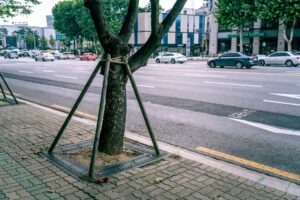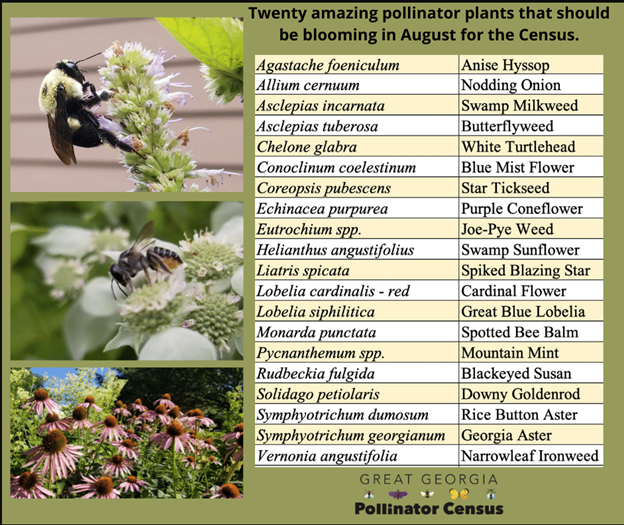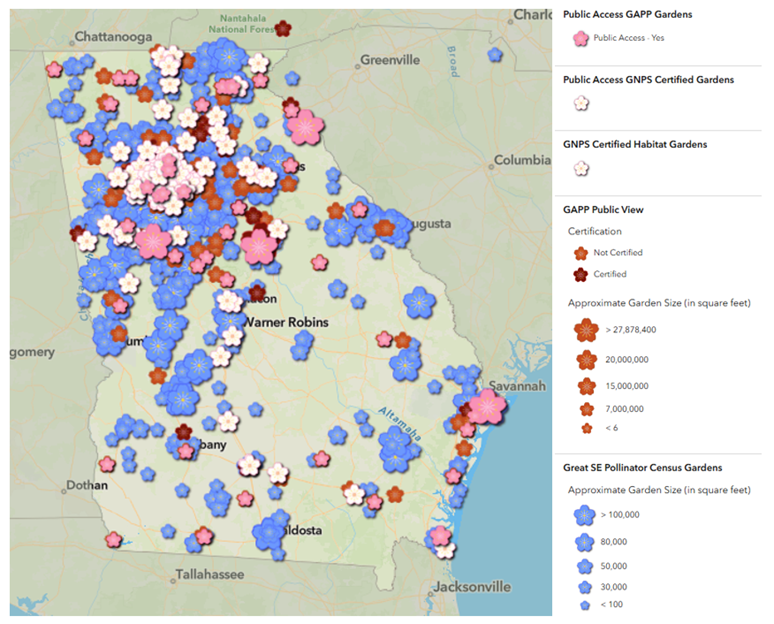
Heather N. Kolich, ANR Agent, UGA Extension Forsyth County
This August 2025 marks the 7th year of the Great Southeast Pollinator Census (GSPC). This annual citizen science event started in 2019 as the Great Georgia Pollinator Census, but has now grown to include five states. South Carolina, through Clemson University Extension, joined the project for the 2022 census, followed by North Carolina State University Extension in 2023, University of Florida Extension in 2024, and Auburn/ Alabama Cooperative Extension will participate in the 2025 census.

Created by UGA Extension Community and School Gardens Coordinator Becky Griffin, the project has consistently met its three stated goals:
- Educate gardeners about using plants that provide nutrition for pollinators, are tolerant of summer droughts, and are resistant to pests and diseases.
- Increase entomological literacy (and wonder) among Georgia residents in general, including children.
- Generate useful data about Georgia pollinator populations.
Among the useful data generated is that 80-90% of the observed pollinator insects were wild bees, not honey bees. GSPC participants learned about other pollinators, too, such as wasps, flies, butterflies, and moths.
Even more importantly, inspired by participating in GSPC, over 3,400 participants have reported that they created or expanded a pollinator garden since 2019. These gardens create daisy-chains of pollinator habitat throughout Georgia that are now expanding into our neighboring states.

Why pollinator gardens matter
Pollinators are critical components of environmental sustainability as well as food production. About 75 percent of flowering plants require insects or animal pollinators to fertilize the flowers so that they can produce the berries, fruits, nuts, and seeds that feed birds and wildlife and provide for the next generation of plants. Over 1,200 of the cultivated crops that humans rely on for food – from apples to zucchini – need pollinators. In Georgia, where agriculture contributes around $91.4 billion to our economy each year, insect pollination has an annual value of $635 million.

Unfortunately, pollinator populations have been in decline for several decades, and habitat loss is one of the primary threats to pollinator populations around the world. In the 1990s, the increase of people moving to Georgia stimulated growth and expansion in the housing industry that continues today.
Land development to serve people converted farms, fields, and forests into subdivisions and shopping centers. Native trees, grasses, shrubs, and forbs that pollinators, migratory birds, and native wildlife rely upon for food, shelter, and nesting materials – habitat – were destroyed and fragmented. In many areas, the plants selected for landscaped islands within the concrete expanse are nonnative species with limited biodiversity. Pollinators simply can’t make a living in that environment.
The garden connection
Colony-dwelling pollinators like bumble bees and honey bees need an abundance of flowering plants near their hives. And they need that abundant supply of pollen and nectar from early spring to late fall. In addition to nectar sources, butterflies and moths need host plants to feed their young during the caterpillar life stage. Many butterflies and moths require particular host plants, such as spicebush (Lindera benzoin) and sassafras (Sassafras albidum) for the beautiful spicebush swallowtail butterfly; wild violets (Viola sororia) for cheerful, active fritillary butterflies; and pawpaws (Asimina triloba)for the striking zebra swallowtails.
Private landowners and managers are the stewards for pollinator habitat, wildlife habitat, and ecosystem health. While individually we might only own or care for a quarter of an acre, collectively, over 93% of the 38+ million acres that make up Georgia is privately owned. If the 12 families on my street all plant and manage our landscapes to protect pollinators and our local environment, our little dots of pollinator gardens merge to create a larger habitat. If the residents in all of the homes of my subdivision added native plants, reduced pesticide usage, and increased the variety of flowering plants, together we could provide over 82 acres of pollinator and wildlife sanctuary.

How does your garden grow?
Participating in the 2025 Great Southeast Pollinator Census on August 22 and 23, 2025 can help you learn more about how well your own garden or landscape supports pollinators. And if you’re inspired to install, expand, or improve a pollinator garden, the Connect to Protect Garden Guide can help you plan and get started. This signature pollinator garden certification program from the University of Georgia State Botanical Garden is designed to help gardeners develop attractive gardens that support all life stages of native insects while enriching the natural food web – from soil health to restoring native biodiversity including plants, birds, and wildlife.

These resources can help you grow your garden and convert your landscape into a rich habitat that supports pollinators and the local ecosystem: